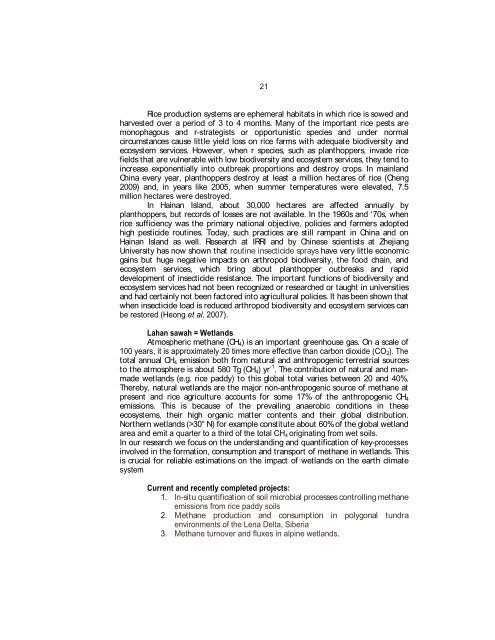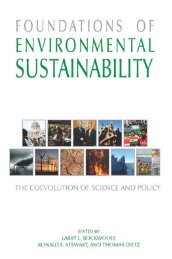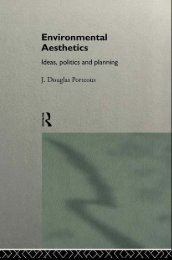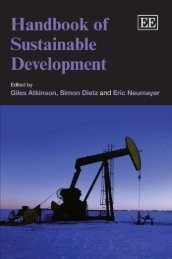You also want an ePaper? Increase the reach of your titles
YUMPU automatically turns print PDFs into web optimized ePapers that Google loves.
21<br />
Rice production systems are ephemeral habitats in which rice is sowed and<br />
harvested over a period of 3 to 4 months. Many of the important rice pests are<br />
monophagous and r-strategists or opportunistic species and under normal<br />
circumstances cause little yield loss on rice farms with adequate biodiversity and<br />
ecosystem services. However, when r species, such as planthoppers, invade rice<br />
fields that are vulnerable with low biodiversity and ecosystem services, they tend to<br />
increase exponentially into outbreak proportions and destroy crops. In mainland<br />
China every year, planthoppers destroy at least a million hectares of rice (Cheng<br />
2009) and, in years like 2005, when summer temperatures were elevated, 7.5<br />
million hectares were destroyed.<br />
In Hainan Island, about 30,000 hectares are affected annually by<br />
planthoppers, but records of losses are not available. In the 1960s and 70s, when<br />
rice sufficiency was the primary national objective, policies and farmers adopted<br />
high pesticide routines. Today, such practices are still rampant in China and on<br />
Hainan Island as well. Research at IRRI and by Chinese scientists at Zhejiang<br />
University has now shown that routine insecticide sprays have very little economic<br />
gains but huge negative impacts on arthropod biodiversity, the food chain, and<br />
ecosystem services, which bring about planthopper outbreaks and rapid<br />
development of insecticide resistance. The important functions of biodiversity and<br />
ecosystem services had not been recognized or researched or taught in universities<br />
and had certainly not been factored into agricultural policies. It has been shown that<br />
when insecticide load is reduced arthropod biodiversity and ecosystem services can<br />
be restored (Heong et al. 2007).<br />
Lahan sawah = Wetlands<br />
Atmospheric methane (CH4) is an important greenhouse gas. On a scale of<br />
100 years, it is approximately 20 times more effective than carbon dioxide (CO2). The<br />
total annual CH4 emission both from natural and anthropogenic terrestrial sources<br />
to the atmosphere is about 580 Tg (CH4) yr -1 . The contribution of natural and manmade<br />
wetlands (e.g. rice paddy) to this global total varies between 20 and 40%.<br />
Thereby, natural wetlands are the major non-anthropogenic source of methane at<br />
present and rice agriculture accounts for some 17% of the anthropogenic CH4<br />
emissions. This is because of the prevailing anaerobic conditions in these<br />
ecosystems, their high organic matter contents and their global distribution.<br />
Northern wetlands (>30° N) for example constitute about 60% of the global wetland<br />
area and emit a quarter to a third of the total CH4 originating from wet soils.<br />
In our research we focus on the understanding and quantification of key-processes<br />
involved in the formation, consumption and transport of methane in wetlands. This<br />
is crucial for reliable estimations on the impact of wetlands on the earth climate<br />
system<br />
Current and recently completed projects:<br />
1. In-situ quantification of soil microbial processes controlling methane<br />
emissions from rice paddy soils<br />
2. Methane production and consumption in polygonal tundra<br />
environments of the Lena Delta, Siberia<br />
3. Methane turnover and fluxes in alpine wetlands.





